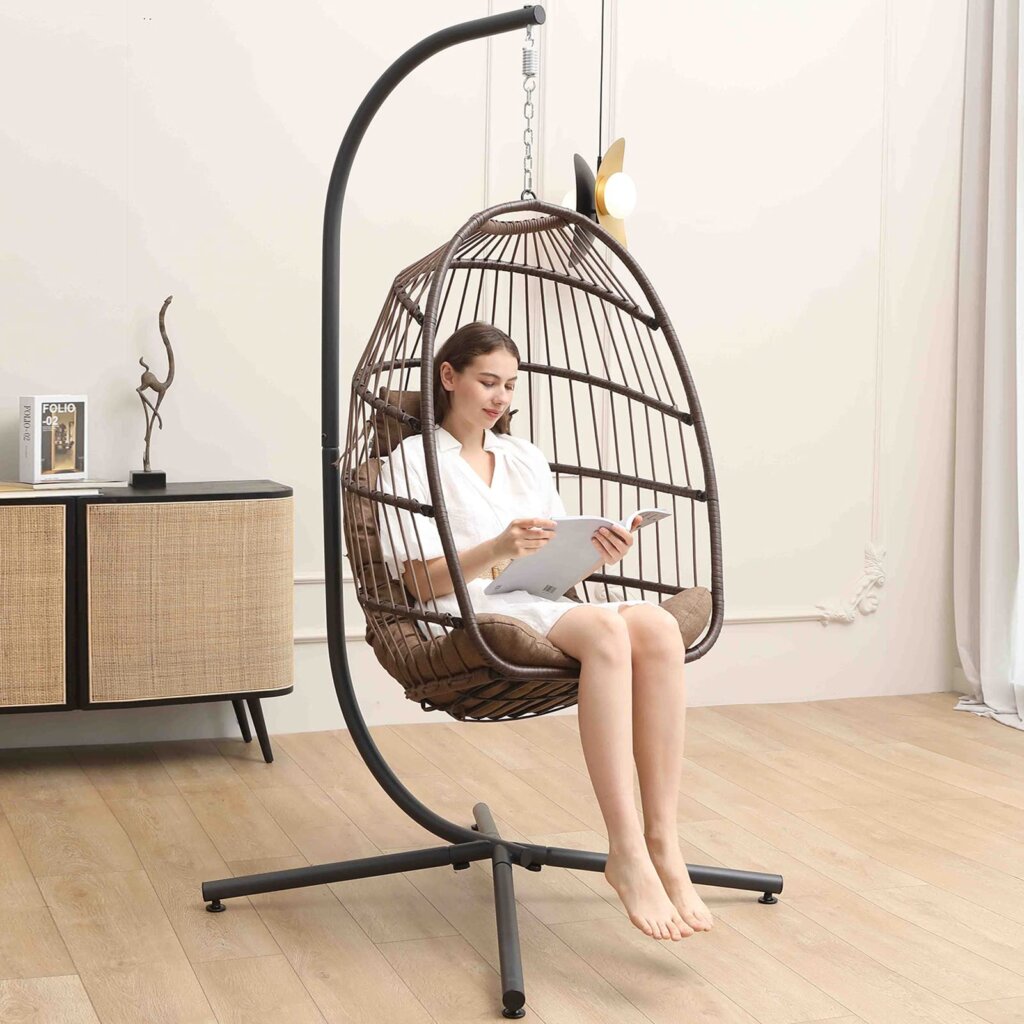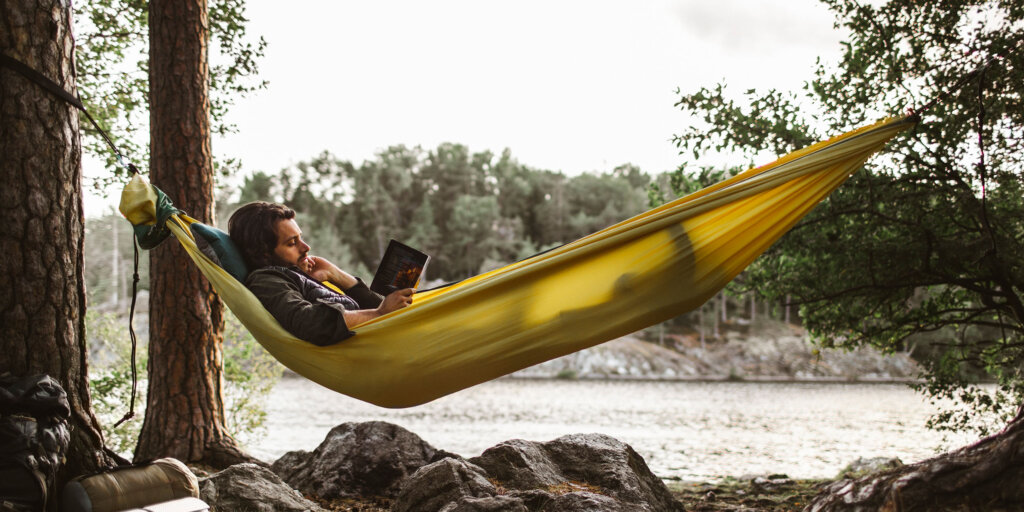- 8 Airplane Footrest Hammock!Travel comfortably - October 9, 2023
- top 7 Pool Float Water Hammock for a Relaxing Summer - October 9, 2023
- top 5 Space SaverSingle Hammock Stand Maximize Comfort and Space - October 9, 2023
Are you a hammock enthusiast who loves to lounge and sway in the gentle breeze? There’s nothing quite as relaxing as enjoying the outdoors while gently swaying in a comfortable hammock.
However, if you’ve ever experienced your hammock flipping over in strong winds, you know how frustrating and potentially dangerous it can be. But fear not! We’re here to help you keep your hammock stable and secure, even when faced with gusty winds.
To prevent a hammock from flipping in the wind, ensure it is properly anchored. Use sturdy tree straps or heavy-duty anchors, keeping the hammock taut. Position it perpendicular to the wind direction, with a slight sag for flexibility. Adding weight to the hammock’s center, such as a backpack, can also help stabilize it.
In this blog post, we’ll delve into expert tips and tricks that will ensure your hammock remains in its proper position, providing you with uninterrupted moments of blissful relaxation.
Whether you’re planning a camping trip, setting up a hammock in your backyard, or lounging by the beach, we’ve got you covered.
We’ll explore a range of practical techniques, including proper hammock setup, strategic positioning, and essential accessories that will significantly reduce the chances of your hammock flipping in the wind.
Our comprehensive guide will equip you with the knowledge and tools necessary to create a wind-resistant hammock setup, allowing you to enjoy your tranquil moments without worry.
So, if you’re tired of your hammock misbehaving when the wind picks up, keep reading and discover the secrets to keeping your hammock stable and secure, no matter the weather conditions.
Understanding the Factors Hammock Flipping in the Wind
As someone who loves hammock camping, I’ve had my fair share of experiences where my hammock flipped over due to strong winds. Over time, I’ve learned that there are several factors that contribute to this problem. Here are some of the most important ones to keep in mind:
The physics behind the hammock flipping in the wind
When a hammock is exposed to wind, it creates a sail-like effect that can cause it to flip over. This is because the wind creates an imbalance of forces that can overpower the gravitational pull on the hammock. The key to preventing this from happening is to minimize the surface area of the hammock that is exposed to the wind.
The role of wind speed, direction, and gusts in affecting hammock stability
The strength and direction of the wind are crucial factors in determining how stable a hammock will be. Strong and gusty winds can create sudden forces that can easily flip a hammock over. It’s important to set up your hammock in a sheltered location or use windbreaks to reduce the impact of the wind.
How the hammock’s design and materials can influence its tendency to flip
The design and materials of a hammock can have a significant impact on its stability in windy conditions. A hammock with a deep sag and a wider base will be more stable than a taut and narrow one. Additionally, hammocks made from heavier materials like canvas or nylon tend to be more stable than those made from lighter materials like silk or mesh.
Significance of proper setup and alignment
Proper setup and alignment are crucial to preventing a hammock from flipping over. Make sure that the anchor points are secure and at the right height. The hammock should be hung at a 30-degree angle to the ground, with the suspension straps or ropes at a 30-degree angle to the anchor points.
Importance of balancing weight distribution
Balancing weight distribution is essential for maintaining stability in a hammock. Avoid jumping or laying horizontally in the hammock, as this can create an imbalance of forces that can cause it to flip over. Instead, sit or lay diagonally in the hammock to distribute your weight evenly.
Distance to the Ground
The distance to the ground is an important factor to consider when setting up a hammock. A hammock that is too high off the ground will be more susceptible to wind forces, while one that is too low can create an uncomfortable sag. Aim for a height of 18-24 inches off the ground.
Impact of anchor point height on wind effect
The height of the anchor points can also affect the stability of a hammock in the wind. Anchor points that are too high can create a pendulum effect that can cause the hammock to swing uncontrollably, while those that are too low can create too much tension on the suspension straps or ropes.
Angle and Measurement
Proper strap and rope measurement is essential for maintaining stability in a hammock. Make sure that the straps or ropes are long enough to create a 30-degree angle, but not too long that they create too much slack. Additionally, ensure that the lengths and angles on both sides are symmetrical for maximum stability.
Choosing the Right Hammock
Finally, choosing the right hammock is essential for preventing it from flipping over in the wind. Look for a hammock that is designed for stability and made from high-quality materials. Additionally, consider the size and weight capacity of the hammock to ensure that it can accommodate your needs.
While there are various factors that can contribute to the stability of a hammock in windy conditions, here are five popular hammock brands known for their stability and resistance to flipping in the wind:
- Hennessy Hammock: Hennessy Hammocks are renowned for their innovative designs and superior stability. They often feature integrated bug nets and rainfly systems, providing added protection in different weather conditions.
- ENO (Eagles Nest Outfitters): ENO hammocks are highly regarded for their durability and stability. They offer a range of models, including double hammocks and those with specialized suspension systems for enhanced stability in windy conditions.
- Grand Trunk: Grand Trunk hammocks are designed with durability and stability in mind. They offer hammocks made from high-quality materials and incorporate features like reinforced stitching and adjustable suspension systems to minimize flipping in the wind. Check the price at this link
- Kammok: Kammok hammocks are known for their rugged construction and excellent stability. They are often made from tear-resistant and weather-resistant materials, making them suitable for various outdoor environments. Check the Price at this link.
- Warbonnet Outdoors: Warbonnet Outdoors produces hammocks specifically designed for camping and outdoor enthusiasts. Their hammocks feature advanced suspension systems and durable materials that help prevent flipping in windy conditions. Check The price at this link
Overall, preventing a hammock from flipping over in the wind requires a combination of proper setup, balancing weight distribution, and choosing the right hammock. By keeping these factors in mind, you can enjoy a comfortable and stable hammock camping experience.

Credit: www.amazon.com
Tips to Prevent Hammock Flipping in the Wind
As someone who loves relaxing in a hammock, I know how frustrating it can be when it flips over in the wind. Fortunately, there are some simple steps you can take to prevent this from happening. Here are some tips to keep your hammock stable and secure:
Step-by-Step Process of Setting Up a Hammock for Stability
When setting up your hammock, it’s important to follow a few key steps to ensure that it’s stable and secure. First, choose a spot that is protected from the wind, such as a sheltered area between two trees or against a wall. Next, select sturdy anchor points, such as trees or posts, that can support your weight and the weight of the hammock.
Importance of Selecting Sturdy Anchor Points, Such as Trees or Posts
The anchor points you choose are crucial to the stability of your hammock. Make sure they are strong enough to support your weight and the weight of the hammock, and that they are securely anchored into the ground. If you’re not sure whether a particular anchor point is sturdy enough, it’s better to err on the side of caution and choose a different spot.
How to Adjust the Tension and Height to Enhance Stability
Adjusting the tension and height of your hammock can also help improve its stability. Make sure the hammock is taut and level, with no sagging or drooping. You can adjust the tension by tightening or loosening the straps or ropes that attach the hammock to the anchor points.
Recommend Using Reliable Hammock Suspension Systems and Straps
Using a reliable hammock suspension system and straps can also help prevent flipping in the wind. Look for suspension systems that are designed for your specific type of hammock, and make sure they are rated to support your weight and the weight of the hammock.
Properly Balance in Your Hammock
When getting into your hammock, it’s important to do so in a way that maintains proper balance. Use gentle entry and weight distribution techniques to avoid sudden movements that could cause the hammock to flip. Once you’re in the hammock, try lying diagonally to distribute your weight more evenly and improve stability.
Reduce the Distance between the Ground and the Hammock
Reducing the distance between the ground and the hammock can also help improve stability. If your hammock is too high off the ground, it will be more susceptible to flipping in the wind. Try adjusting the straps or ropes to lower the hammock closer to the ground.
Balancing Wind Resistance and Safety
While it’s important to protect your hammock from the wind, it’s also important to ensure that it’s safe and secure. Avoid setting up your hammock in areas that are prone to strong gusts of wind, and make sure the hammock is properly anchored and balanced.
Taking Measurements for a Well-Adjusted Setup
Taking measurements can also help ensure that your hammock is well-adjusted and balanced. Measure the distance between the anchor points and the height of the hammock, and adjust as necessary to achieve a 30-degree angle for better balance.
Ensuring Symmetrical Strap and Rope Lengths
Finally, make sure that the straps or ropes you use to attach the hammock to the anchor points are of equal length. This will help ensure that the hammock is evenly balanced and stable.
By following these tips, you can enjoy your hammock without worrying about it flipping over in the wind.
Should I choose a certain type of hammock fabric or design to minimize flipping in the wind?
When it comes to minimizing flipping in the wind, the type of hammock fabric and design can make a significant difference. Here are some things to consider:
Fabric
- Weight: A heavier fabric can help weigh down the hammock and prevent it from flipping over. Look for hammocks made from durable materials like canvas, polyester, or Sunbrella fabric.
- Weave: The weave of the fabric can also affect how much wind the hammock catches. A tighter weave can reduce wind resistance and minimize flipping. Look for hammocks with a tight, dense weave.
- Breathability: While a tight weave can help minimize flipping, it can also reduce breathability and make the hammock feel hot and stuffy. Look for hammocks made from breathable fabrics like cotton or mesh.
Design
- Size: A larger hammock can catch more wind and be more prone to flipping. Look for hammocks that are appropriately sized for your body and the space you’ll be using it in.
- Shape: Hammocks with spreader bars can be more stable in windy conditions, as they keep the hammock flat and prevent it from flipping over. However, they can also be less comfortable and more difficult to get in and out of. Non-spreader bar hammocks may be more prone to flipping, but they can also be more comfortable and easier to use.
- Suspension: The way you suspend your hammock can also affect how much it flips in the wind. A hammock that is hung too taut can be more prone to flipping. Make sure to hang your hammock with a slight sag to reduce wind resistance.
Choosing the right hammock fabric and design can help minimize flipping in the wind. Look for heavier, tightly woven fabrics and consider the size, shape, and suspension of your hammock.
Choosing the Right Location
When it comes to setting up a hammock, choosing the right location is key to preventing it from flipping in the wind. I always look for areas that offer natural wind barriers, such as trees or buildings. These features can help block the wind and keep the hammock more stable.
It’s important to avoid open and exposed spaces with strong wind currents. These areas can cause the hammock to sway uncontrollably, making it difficult to relax or even stay in the hammock. Instead, I try to find sheltered spots that are protected from the wind.
To assess wind conditions, I often use a simple trick. I’ll take a small piece of tissue paper or a feather and hold it up in the air. This can help me see which way the wind is blowing and how strong it is. I’ll then look for spots that are shielded from the wind in that direction.
When setting up a hammock, I also make sure to check for any potential hazards. I look for things like sharp rocks, uneven ground, or low-hanging branches that could damage the hammock or cause injury.
By taking the time to choose the right location, I can enjoy a relaxing and comfortable hammock experience without worrying about it flipping in the wind.
Additional Stability Measures
When it comes to keeping your hammock stable in windy conditions, there are a few supplementary techniques that can be used to ensure your comfort and safety.
One option is to use guy lines and stakes to create additional support. Guy lines are ropes that are attached to the hammock and then anchored to the ground with stakes. This creates a stable base and prevents the hammock from flipping. Be sure to angle the stakes away from the hammock to create tension in the lines.
Another option is to use spreader bars or a ridgeline to prevent flipping. Spreader bars are bars that are attached to the ends of the hammock, spreading it out and creating a flatter surface. A ridgeline is a rope that is attached to the trees and runs above the hammock, providing additional support and stability.
Adjustable hammock stands can also be used for added stability. These stands can be adjusted to create tension in the hammock, preventing it from flipping over. Be sure to follow the manufacturer’s instructions for proper setup and use.
Finally, sandbags or weights can be used to anchor the hammock. Simply place the bags or weights on the ground near the hammock’s anchor points to create additional stability.
By using these supplementary techniques, you can enjoy your hammock even in windy conditions without worrying about flipping or discomfort.
Maintenance and Safety Considerations
As a hammock owner, I take the responsibility of maintaining and inspecting my hammock seriously. Regular maintenance and care are essential to ensure the longevity and safety of your hammock.
First, inspect your hammock before each use. Check for signs of wear and tear, such as frayed ropes or fabric, and repair or replace as necessary. It’s also essential to check the weight capacity of your hammock and ensure that it can support your weight.
When it comes to cleaning your hammock, I recommend following the manufacturer’s instructions. Generally, you can hand wash your hammock with mild soap and water, but avoid using bleach or harsh chemicals. Once clean, hang your hammock to air dry completely before storing it.
Proper storage is also crucial in maintaining your hammock’s quality. Store it in a cool, dry place, away from direct sunlight, to prevent fading and damage from moisture. You can also use a storage bag to protect it from dust and pests.
Safety should always be a top priority when using a hammock. Avoid excessive movement, as it can cause the hammock to flip or tip over. Also, be mindful of the weight capacity and avoid overloading your hammock.
Lastly, consider your personal comfort and ergonomic positioning when using your hammock. Adjust the height and tension of your hammock to find the most comfortable position for your body. A properly positioned hammock can provide excellent support and relaxation for your body.
By following these maintenance and safety considerations, you can enjoy your hammock for years to come while ensuring your safety and comfort.
Are hammock stands worth it?
There are a few things to consider when purchasing a hammock stand. The most important factor is how often you plan to use it. If you are an avid hammock user, then a stand is worth the investment.
Hammock stands provide many benefits. They are great for use in small spaces, on balconies or decks, and make it easy to set up your hammock without having to find two trees or posts that are the perfect distance apart. Hammock stands are also portable so you can take them with you when you travel.
Another thing to consider is the type of hammock you have. Some hammocks come with their own stands, while others do not. If you have a hammock that does not come with a stand, then you will need to purchase one separately.
Hammock stands range in price from around $30 to $200, depending on the material, design, and size.In general, hammock stands are worth the investment if you are a regular hammock user. They provide many benefits and make it easy to set up your hammock without having to find two trees or posts that are the perfect distance apart.
Frequently Asked Questions
How do I keep my hammock stand stable in windy conditions?
I have found that using sandbags or weights at the base of the hammock stand can help keep it stable in windy conditions. You can also try securing the stand to the ground using stakes or anchors.
Are there any tricks to making a hammock more stable in the wind?
Yes, there are a few tricks you can try to make your hammock more stable in the wind. First, make sure to spread out your weight evenly in the hammock. You can also try using a more stable suspension system, such as a hammock stand or a suspension system with ridgelines. Additionally, choosing a more sheltered spot where the wind is not as strong can also help.
Are there any particular knots or setups that can help keep a hammock steady in the wind?
Yes, there are a few knots and setups that can help keep a hammock steady in the wind. One popular knot is the bowline knot, which creates a secure loop at the end of the rope. You can also try using carabiners or other hardware to secure the hammock to the suspension system.
How do I keep my hammock stand from tipping over?
To keep your hammock stand from tipping over, make sure to use a heavy-duty stand that is designed to withstand windy conditions. You can also try using sandbags or weights at the base of the stand to add extra stability.
How do I secure a hammock without trees or posts?
If you don’t have trees or posts to secure your hammock to, you can try using a hammock stand or a portable hammock stand that can be set up anywhere. You can also try using wall anchors or other hardware to secure the hammock to a wall or other sturdy structure.
Can I leave my hammock outside in windy conditions?
While it is generally safe to leave your hammock outside in windy conditions, it is important to take precautions to prevent it from flipping over. Make sure to secure the hammock to a sturdy structure and use sandbags or weights to add extra stability.
Why does my hammock lean to one side?
A hammock may lean to one side if the weight is not distributed evenly or if the suspension system is not properly set up. Make sure to spread out your weight evenly in the hammock and adjust the suspension system as needed to keep the hammock level.
What are some signs or indicators that a hammock may be at risk of flipping over in the wind?
Some signs that a hammock may be at risk of flipping over in the wind include excessive swaying or rocking, uneven weight distribution, and a lack of stability in the suspension system.
Can adding additional weight to the hammock help stabilize it in windy conditions?
Adding additional weight to the hammock can help stabilize it in windy conditions, but it is important to make sure that the weight is distributed evenly and does not exceed the weight capacity of the hammock. You can try using sandbags or weights at the base of the hammock to add extra stability.
HAMMOCKS – The three big mistakes people often make
Conclusion
keeping a hammock from flipping in the wind requires proper setup and location selection. It is important to choose a sturdy and heavy-duty hammock and use tie-down straps to secure it in place. Additionally, selecting a more covered and wind-protected spot can greatly reduce the risk of flipping.
Proper balance and weight distribution in the hammock are also crucial factors to consider. Ensuring that weight is evenly distributed and entering the hammock correctly can prevent accidents and provide a more comfortable experience.
By following the recommended techniques, you can enjoy a secure and relaxing hammock experience. Remember to always prioritize safety and choose the best setup and location for your hammock.
In summary, keeping a hammock from flipping in the wind involves the following key points:
- Choose a sturdy and heavy-duty hammock
- Use tie-down straps to secure the hammock in place
- Select a more covered and wind-protected spot
- Ensure proper balance and weight distribution in the hammock
By following these recommendations, you can enjoy a safe and enjoyable hammock experience.







Pingback: Can Wise Owl Hammock Withstand Rain? All You Need To Know!